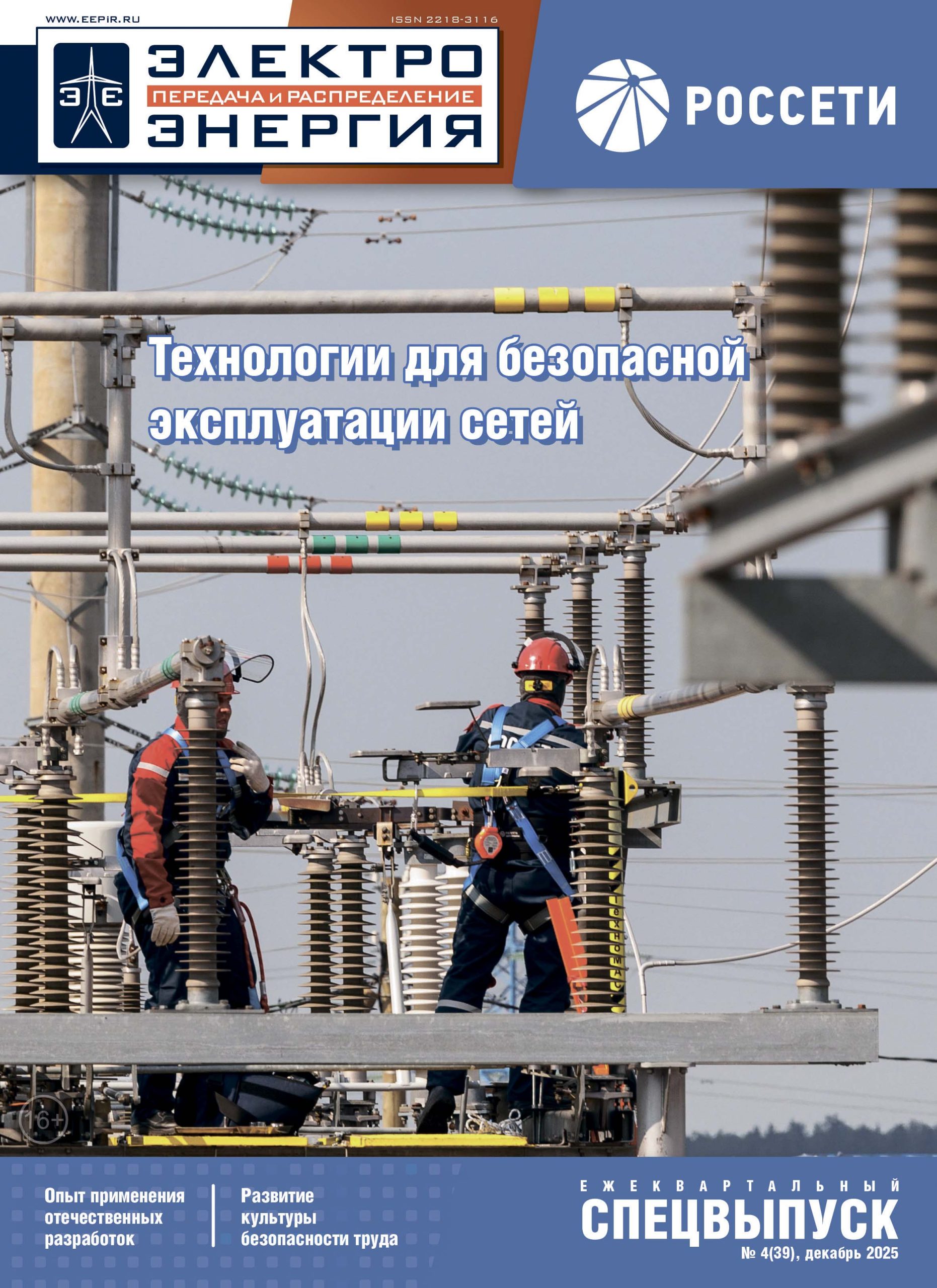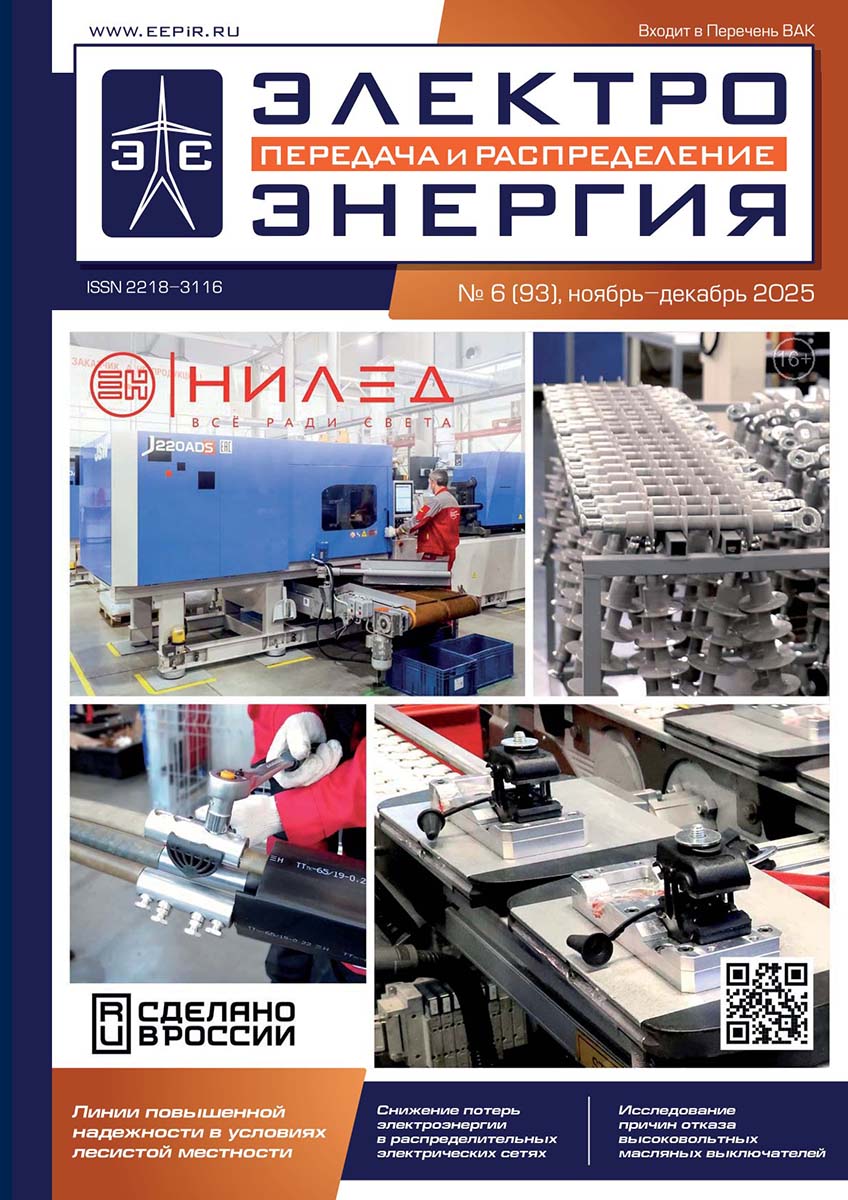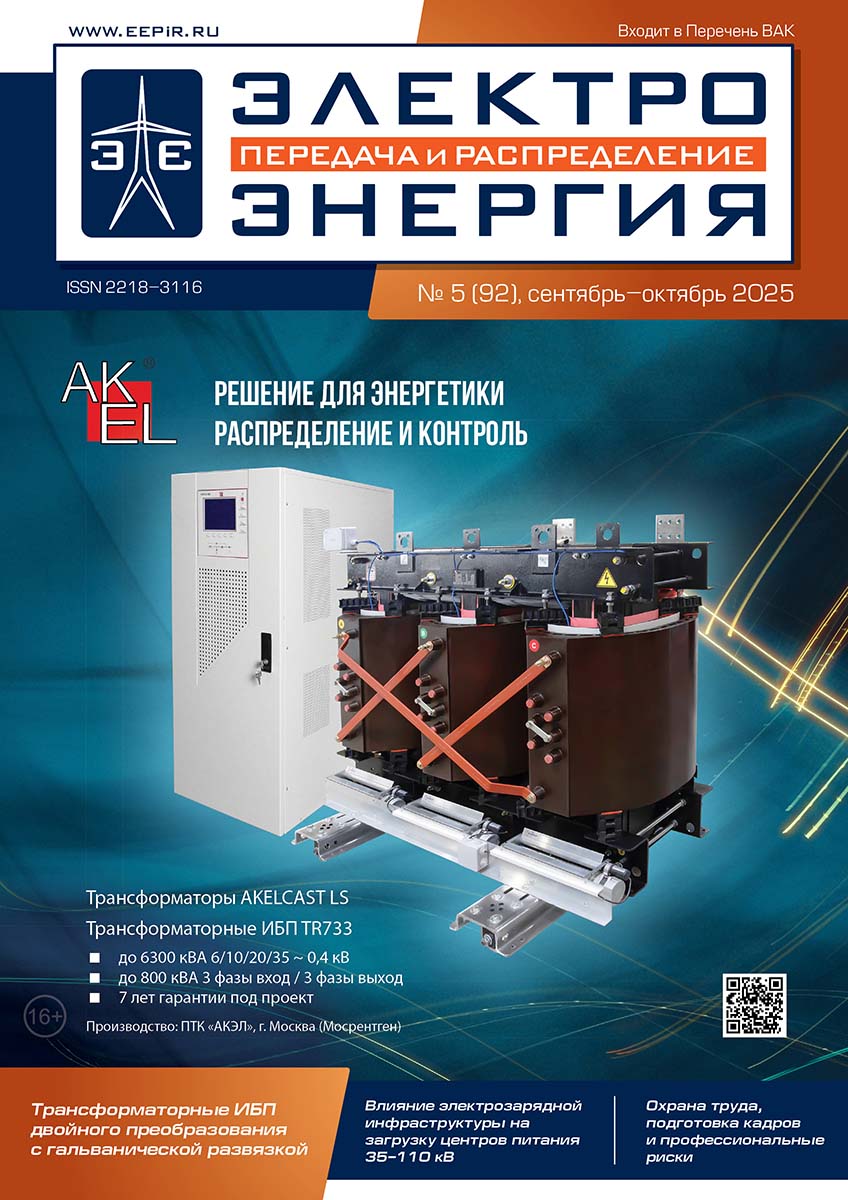
28 августа 2025
АНОНС «ЭЛЕКТРОЭНЕРГИЯ. Передача и распределение» № 4(91), июль-август 2025
15 статей в открытом доступе
Оформить подпискуОформите подписку, чтобы получить доступ ко всем материалам выпуска, или купите нужную статью отдельно
Уже есть подписка? Тогда авторизуйтесь.
СОБЫТИЯ
СОБЫТИЯ
ЭНЕРГОСНАБЖЕНИЕ
DOI: 10.65209/2218-3116-2025-4-91-36-44
УДК 621.311:004.855
ЭНЕРГОСНАБЖЕНИЕ
DOI: 10.65209/2218-3116-2025-4-91-46-55
УДК 621.316.3
УПРАВЛЕНИЕ СЕТЯМИ
КАБЕЛЬНЫЕ ЛИНИИ
КАБЕЛЬНЫЕ ЛИНИИ
ВОЗДУШНЫЕ ЛИНИИ
ПОДГОТОВКА КАДРОВ
РЕЛЕЙНАЯ ЗАЩИТА И АВТОМАТИКА
РЕЛЕЙНАЯ ЗАЩИТА И АВТОМАТИКА
ДИАГНОСТИКА И МОНИТОРИНГ
DOI: 10.65209/2218-3116-2025-4-91-110-119
УДК 621.315.61
ДИАГНОСТИКА И МОНИТОРИНГ
ОБОРУДОВАНИЕ
ОБОРУДОВАНИЕ
ОХРАНА ТРУДА
DOI: 10.65209/2218-3116-2025-4-91-138-145
УДК 331.453:621.31
ОХРАНА ТРУДА
DOI: 10.65209/2218-3116-2025-4-91-146-151
УДК 331.453:621.31
ПРОИЗВОДСТВЕННЫЙ ТРАВМАТИЗМ
EVENTS
The Xth International Scientific and Technical Conference «Development and Reliability Improvement of Distribution Network» and Technical Exhibition «EEPIR-2025»
Event review
The journal «ELECTRIC POWER. Transmission and Distribution»: from the very first issue to the promising future
On the 15-year anniversary of the edition
GUEST ISSUE
Il’shat Fardiev: the Discipline of Action and the Discipline of Thought
Interview with I.Sh. Fardiev, Director General of JSC Grid Company
EMPHASIS
Update of the Electric Installation Code with Regard to Present-Day Challenges
OOO PO Energozhelezobetoninvest
POWER SUPPLY
Single Phase-to-Ground Fault Protection in the Networks with Isolated and Compensated Neutral
Tavrida Electric Company
Methodology for Determining Informative Features for the Power System Emergency Control Based on Machine Learning Algorithms
Senyuk M.D., Pazderin A.V., Chernykh I.V., Klassen V.V. (Ural Federal University n. a. the First President of Russia B. N. Yeltsin)
Abstract. The characteristics of modern power systems impose increased requirements for the speed and adapt ability of emergency control, which can be satisfied through the use of machine learning algorithms. The non-deterministic basis of this class of algorithms allows, by identifying fuzzy and implicit correlations in the training data, to synthesize the emergency control law at the pace of the transient process. One of the key tasks when using machine learning algorithms in emergency control of power systems is to ensure speed by reducing the dimensionality of the problem being solved. The study presents a methodology for solving the problem of selecting informative features for synthesizing the emergency control law based on machine learning algorithms. The methodology was tested on data obtained as a result of numerical modeling using the IEEE24 mathematical model. The conclusions present the main results of the study and directions for future work.
Keywords: power system, emergency control, informative features, machine learning, numerical modeling
Updating the Methodology for Determining the Design Electrical Loads of Public Buildings (Using the Example of the Moscow City Power Supply System)
Shvedov G.V. (NRU «MPEI», Moscow)
Abstract. The development of electrical technologies and the improvement of the energy efficiency of electrical appliances have led to a reduction in the maximum electrical load of consumers. The current standards for determining the design electrical loads of public buildings given in RD 34.20.185-94 and SP 256.1325800.2016 have not been updated for over 30 years. The paper attempts to update the methodology for determining the design electrical loads for widespread public buildings within residential areas of urban power supply systems. The types of public buildings for which electrical loads need to be standardized are identified. As the initial data, a dataset of hourly electricity consumption over 3 years for 91 public buildings of various purposes was compiled. It has been found that the actual maximum loads are significantly lower than the current standards. In the conditions of modern diversity in building construction, it has been determined that relative electrical loads should be defined per square meter of the total area of buildings. Based on the calculated relative electrical loads of buildings, new standards for electrical loads have been proposed. The application of these new standards will improve the energy efficiency of newly constructed power trans mission lines and transformers in step-down substations.
Keywords: electrical load, relative load standard, public buildings, urban power supply system, electrical grid design
Online Technical Maintenance of Consumer Electric Installations
PJSC Rosseti Moscow region
GRIDS MANAGEMENT
Standardization of Requirements to the 20 kV Network in a Metropolitan City
JSC “UNECO”
QuaSy DSS – the Unifi ed Smart Platform for Network Management
OOO Dun Rose
CABLE LINES
The Effectiveness of Using Single Core and Three-Core Medium Voltage Cables with Cross-Linked Polyethylene Insulation
Vysotskiy M.E. (Belorussia National Technical University, Minsk)
Korotkevich A.M. (OOO «PO «Energocomplekt»)
Abstract. This paper presents a comparative economic analysis of two medium-voltage (MV) cable line configurations using cross linked polyethylene (XLPE) insulation: a line with a single three core cable versus a line with three single-core cables in a trefoil arrangement. The optimal design and conductor cross-section are determined by minimizing the total life-cycle costs. A nomogram is developed to identify the most economically viable configuration based on load current and loss load factor. The study demonstrates that selecting a conductor size based solely on its ampacity (permissible current-carrying capacity) results in suboptimal solutions with excessive long-term operational expenses. To aid in this process, the paper proposes a software tool for dynamic calculations to select the optimal cable configuration using up-to-date market data.
Keywords: cable lines, economic selection of cross-section, total discounted costs, sheath losses, economic current density, nomogram
Divisible Pipes MODUL: Reliable Protection of Cable Lines in Operation Without Rerouting
ENERGOTEK Company
OVERHEAD TRANSMISSION LINES
Assessment of a 6-20 kV Transmission Line Failure Rate in the Forest Area Caused by Tree Falls at a Different Distance from the Wire
Gvozdev D.B., Ivanov R.V., Bolonov V.O., Torokhtunov A.P. (PJSC Rosseti Moscow Region)
Tul’skiy V.N. (NRU «MPEI», Moscow)
Abstract. Estimated calculations of the 6-20 kV transmission line failure rate in forests during the tree fall depending on the distance between the tree and the overhead line wire have been performed by the authors with the aim to provide the consumer power supply reliability in unfavourable weather conditions to minimize negative impacts. The calculation results have been compared with requirements of the valid normative documentation on ranging line rights-of way and the international practice of vegetation management.
Keywords: transmission line failure rate, overhead line rights-of-way, fenced off areas, reliability of power supply, tree fall, falling tree trunk energy, tree cutting, distribution networks, unfavorable weather conditions
PERSONNEL TRAINING
The Third Annual Competition of Contractors’ Electricians in Tatarstan: Expertise and Innovations
Review of the competition «Best crew of distribution network electricians among contractors in 2025»
RELAY PROTECTION AND AUTOMATION
Statistic Review of Fault Location Detection Methods and Related Problems for Overhead Transmission Lines for 110 kV and Higher Voltage
PJSC Rosseti
Innovations, Functionality and the Complex Approach from INBRES Company
Relay Protection and Automation Devices of UNIT-M300 Series Produced by Unitel Engineering Company
DIAGNOSTICS AND MONITORING
Diagnosis of SF6 HV Equipment Based on the Analysis of Internal Insulation Degradation Products
Daryan L.A., Terekhov A.A. (Tehnicheskaya Inspekciya EES AO)
Abstract. The results of studying the qualitative and quantitative composition of SF6 degradation products as well as the mechanism of their formation in HV SF6 equipment under the influence of different types of electric discharges and the temperature are presented in the article. The impact of impurities including air, water, metal and carbon bearing particles in the SF6 internal volume is described. The data for determination of SF6 degradation products by means of modern physical-chemical methods – gas chromatography and IR spectrometry – is provided. New data on the impact of discharge energy and frequency, applied voltage polarity, pressure and the exposure time of partial discharges on the formation of SF6 degradation products’ composition is summarized. Interpretation algorithms of SF6 equipment defect types – burrs, conducting particles, impurities, insulation cavities – are presented.
Keywords: SF6 gas, decomposition products, SF6 gas equipment, partial discharge, gas chromatography, infrared spectrometry
Contactless Diagnostics of Power Transmission Lines
Tiguntsev S.G., Shepuraev A.A. (Irkutsk National Research Technical University)
Abstract. The paper examines the diagnostics of slowly developing insulation defects in overhead power transmission lines. The proposed diagnostic method involves preliminary formation of a three-phase mathematical model of the line, periodic measurement of phase currents in the line, and voltages at both ends of the monitored line. Based on the measurements, calculations of the mathematical model’s operating modes are performed, and diagrams of phase voltages and currents along the line are generated from both ends. For a defect-free line, the diagrams from both ends should coincide. The development of insulation defects is characterized by a gradual decrease in resistance and an increase in leakage current to the ground. Consequently, the appearance of a defect leads to changes in the voltage diagrams along the line and their mismatch. The intersection of the voltage diagrams indicates the location of the emerging defect, while the in creasing divergence of the diagrams over time shows the defect’s progression.
Keywords: diagnostics, defect, leakage current, power line insulation, method of phase coordinates
EQUIPMENT
Load Capacity Improvement: the Cost-Effective Approach to Capacity Increase and Service Life Extension of Power Transformers
OOO Autotransformer
Innovative Solutions in Heat Exchange: Development of the Upgraded Water Oil Cooler TCUW Produced by ‘Sistemy Okhlazhdeniya’ Factory
KO3-U-P: Sacrificial Constructions as the Strategy of Protecting the Electric Power Facilities
GK AMAST POWER LINES
LABOR PROTECTION
First Aid: Present-Day Theory and Best Practice
PJSC Rosseti affiliate – Technical Inspection Center, Tactical Medicine Training Center
Training of Personnel in the Field of Electrical Safety for Energy Facilities
Korolev I.V., Borovkova A.M., Medvedev V.T. (NRU «MPEI», Moscow)
Abstract. This article analyzes the personnel requirements established by the Order of the Ministry of Energy of the Russian Federation dated September 22, 2020 no. 796 «On approval of the Rules for working with personnel in electric power organizations of the Russian Federation». Different categories of personnel are considered, as well as mandatory forms of interaction with them depending on these categories. Special attention is paid to pre-examination training, the procedure for verifying the knowledge of employees, the composition of the knowledge verification commission, as well as the specifics of assigning electrical safety groups and types of briefings. The article also highlights the basic principles and methods of training aimed at improving industrial safety, which is crucial for ensuring reliable and safe operation of energy facilities.
Keywords: personnel requirements, electrical safety, increased safety, safe operation
The Main Approaches to the Formation of Ergonomic Requirements for the Operator’s Workplace
Vasilyeva N.V., Kondratieva O.E., Loktionov O.A. (NRU «MPEI», Moscow)
Abstract. The article examines the state of the regulatory framework in the field of ergonomics in Russia, analyzes and identifies areas for updating and improving requirements, taking into account technological progress and modernization of production processes. The lists of ergonomic hazards that can be identified within the framework of the main processes of the occupational safety management system have been compared. The existing approaches to taking into account ergonomic factors have been systematized, and a list of requirements for work places that takes into account ergonomic factors has been propose.
Keywords: ergonomics, occupational safety, occupational safety management system, occupational risks, occupational stress
INDUSTRIAL INJURIES
Dynamics of the Work-Related Injuries in Quarter II of 2025
Russian Federal Service for Ecological, Technical and Atomic Supervision; Association «ERA of Russia»









